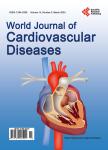Epidemioclinics, Etiologies and Prognosis of Cardiogene Shock State in the Intensive Care Unit of the Cardiology Department of the G-Spot Hospital
Epidemioclinics, Etiologies and Prognosis of Cardiogene Shock State in the Intensive Care Unit of the Cardiology Department of the G-Spot Hospital作者机构:Cardiology Department Point “G” Hospital University Center Bamako Mali Cardiology Department Hospital MALI Bamako Mali Cardiology Department Hospital KATI Bamako Mali Cardiology Department Hospital LUXEMBOURG Bamako Mali Cardiology Department Gabriel Touré Hospital University Center Bamako Mali
出 版 物:《World Journal of Cardiovascular Diseases》 (心血管病(英文))
年 卷 期:2021年第11卷第1期
页 面:20-24页
主 题:Cardiogenic Shock Etiology Prognostic USIC Hospital Point G
摘 要: Objective: The work aimed to describe the etiological and evolutionary aspects of cardiogenic shock in the intensive care unit of the cardiology department (USIC) of the G-spot hospital in Bamako, Mali. Materials and Methods: This was a descriptive cross-sectional study from January 1, 2018 to April 30, 2019 that included all patients admitted to the USIC during this period. Each patient benefited from individual data support with systematic recording of socio-demographic, clinical, complementary and therapeutic data and analyzed with the SOFTWARE SPSS 20.0 French version. Results: The study involved 40 patients out of 311 patients hospitalized in USIC, representing a hospital frequency of 12.86%. Males were the most affected (60%) with a sex ratio of 1.50. The modal class was 41 - 60 years with extremes at 18 years and 89 years. Cardiovascular risk factors were dominated by HTA (27.50%), diabetes and tobacco, each with 22.50%. The general signs were tachycardia (90%), oxygen desaturation (77.50%), impregnable blood pressure (62.50%), agitation (52.50%) and an oliguria (70%). At the electrocardiogram the rhythm was sinus (80%), it was an atrial fibrillation (15%), a ventricular tachycardia (10%) and signs of coronary ischemia (necrosis in 35% and ST over shifted in 20% of cases). At cardiac doppler ultrasound,the left ventricle was dilated (50%), the right cavities dilated (30%), segmental kinetic disorder (40%), the left ventricular systolic function (FEVG) impaired (75%) and valve disease (10%). Biology noted hyper-creatinemia (65%), hyper-glycemia (12.50%), anemia and hyponatremia with 20% frequency each. Among etiology, ischemic heart disease accounted for 57.50% followed by pulmonary embolism 20%, dilated valve cardiomyopathy 7.50% and chronic pulmonary heart 2.50%. The trend in the majority of cases was unfavorable with 60% of deaths. Chronic pulmonary heart and pulmonary embolism were the deadliest with a frequency of 100% and 87.50% respectively. Conclusion: Cardiogenic shock is an infrequent condition with a high mortality of a prognosis. Ischemic heart disease is the most common etiology of the disease.



